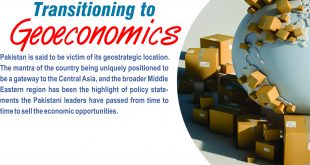Pakistan gained independence in 1947. Born as an inherently weak state with meagre means of survival, the country was anticipated, by some of its opponents, to dissolve within six months of its creation. Yet, Pakistan not only survived as an independent state, it progressed too. However, one wonders if, after seven decades of independence, Pakistan can be called ‘a truly independent’ state.
Characteristics of a truly independent state
International law states the four essential elements of statehood i.e. defined territory, population, government and sovereignty; the last one being the most important element of an independent state. Many geographical entities having defined territory, population and self-government, such as the states of the US and India, though called states, are not states in pure legal terms because they lack sovereignty. On the contrary, Israel is recognised as an independent state due to its sovereignty despite the fact that it lacks a geographically-defined territory. Sovereignty means exclusive independence of a state to define and implement its domestic and foreign policies without external influence or control. A sovereign state is, thus, independent within and without.
Does a truly independent state exist?
Taking a purely legal definition of sovereignty into consideration, it is hard to find a truly independent in today’s globalised world. Not even the US – the so-called superpower – possesses absolute and exclusive sovereignty. The US’ inability to take a decisive, unilateral action in Syria is an evidence of its limitations. The US foreign policy choices are restrained not only by other states but also by non-state actors. Despite a determination to remove its ground forces from Afghanistan by 2014, the US could not do so as its policy was influenced by the actions of Afghan Taliban.
However, the restraints over the US independence are few, rather minimal. It is almost entirely independent in its internal policies and predominantly sovereign in its external policies.
State sovereignty varies in degree but relative independence of states is difficult to measure using sovereignty as an indicator. Sovereignty is an abstract and subjective measure of independence. A system of objective indicators would be more instrumental in measuring the degree of independence of each state.
Indicators to measure ‘degree’ of independence as per the League of Nations Mandate system
The League of Nations established a Mandate system after WWI under which were placed the territories that could not be given an independent status due to various reasons. The mandated territories needed to acquire the following capabilities in order to achieve an independent status:
- Effective control over its territories
- Sustainable self-government and political stability
- Some form of economic self-sufficiency
- Sufficient defence capabilities
Pakistan within the cadre of truly-independent states: A Periphery State
Taking the indicators of the League of Nations Mandate system into account, one can roughly gauge the status of Pakistan’s independence.
Pakistan has failed to establish its writ over its whole territory. The non-existence of state’s writ in FATA enabled Taliban to take over this region. On the political front, Pakistan has been a self-governing state since its inception but its record of political stability has been poor as the country went through alternate periods of civilian and military governments.
Economically, the country has made great progress. Today, Pakistan is the 43rd largest economy in the world in nominal terms. However, it cannot be termed an economically self-sufficient state. With its huge amounts of fiscal deficits, Pakistan is largely dependent upon multinational financial lenders – World Bank, IMF and others – and foreign aid to keep the economy running. International financial lending and aid comes with political strings attached. The economic policy no longer remains independent and casts its spill-over effects on other policies, both domestic and foreign.
On security front, having the 7th largest standing army in the world and a privilege of being the first and, to date, the only nuclear Muslim state, Pakistan holds strong defence capabilities. It has been tackling internal insecurity with resilience. Nevertheless, Pakistan faces a continuous threat of aggression from within and without. To tackle that aggression, it needs continuous supply of latest military technology which has created space for foreign intervention in Pakistan’s independence.
Pakistan has been an independent state for the last seventy years but still it is not a truly independent state. It lags behind in all indicators of independence in varying degrees. Johan Galtung, in his structural theory of imperialism, describes the status of ‘periphery states’ in the international system. Though, apparently independent, these states depend on powerful ‘core’ states for their sustainability. In return, the core states exert a sphere of influence on periphery states and indirectly administer control over some of their policies. Pakistan has predominantly played the role of a periphery or semi-periphery state in the international system.
Hurdles in Pakistan’s way to becoming a truly independent state
Geopolitical, security, political and economic hurdles have hindered Pakistan’s progress towards becoming a truly independent state.
Geopolitical and security hurdles
Pakistan was born a weak and an extremely insecure state owing to its initial internal problems and external geopolitical location. Pakistan shares its largest borders with India and Afghanistan, both chronically non-cordial neighbours. The very rationale of Pakistan’s creation was to free the Muslims of the Subcontinent from the yoke of a hostile majority community. After its creation, this fear of Hindu domination of Muslims transformed into India’s domination of Pakistan. India’s attitude towards division of assets and its dealing with Princely States, especially Jammu & Kashmir, as well as its cutting of water supplies accentuated this fear. Afghanistan, on the other hand, challenged Durand Line, vowed to annex the NWFP province (now Khyber Pakhtunkhwa) of Pakistan, instigated insurgency in the region with the support of the USSR and opposed Pakistan’s UN membership.
All these factors created an acute sense of insecurity among Pakistan’s decision-makers. The future foreign policies and foreign relations of Pakistan were set to be determined within this security paradigm, vis-à-vis India, particularly. For survival and security, Pakistan joined Western blocs – SEATO and CENTO – to get military supplies in the form of aids and soft loans; thus creating a door for foreign meddling into state’s sovereignty. Pakistan has a huge conventional military imbalance with India. This means it needs a continuous supply of latest military technology which, in turn, means continuous foreign interference.
Stephen Cohen, a notable American political scientist, writes in his book that Pakistan’s geopolitical location is its greatest advantage. However, combine geopolitical importance with inherent state weakness and one realises that such states become prone to external great powers’ influence for advancement of their interests. That’s why during most part of its existence, Pakistan played the role of a frontline state to further the US interests e.g. Cold War, Afghan War and the US-led Global War on Terror (GWOT). Being a frontline state gave birth to internal insecurity. Terrorism has cost Pakistan thousands of innocent lives and hindered long-term economic development. Inability to deal with the problem of terrorism and insurgency effectively lies in politics. This is where security hurdles overlap with political hurdles.
Political hurdles
Anatol Lieven, writes in his book, ‘Pakistan: A Hard Country,’ that Pakistan is a weak state but a strong society. This phenomenon has contributed to its extraordinary resilience against all odds, yet the very phenomenon has hindered Pakistan’s progress towards greater independence.
Pakistan has a strong society due to kinship bonds and loyalty. Although a positive thing, problem occurs when these kinship bonds overshadow loyalty towards state. Instead of thinking as a Pakistani nation, the citizens think as regional groups such as Sindhis, Balochis or Islamic groups such as Shias, Sunnis or ethnic groups such as Seraikis, Punjabis and so on. In addition to affecting the national integration, these kinship links have sustained feudal structure and given rise to patronage politics. Feudalism and dynastic politics have hampered the spirit of true self-governance and democratic political parties. It has hampered effective governance and public service delivery.
Moreover, weakness of political parties due their inability to deliver on good governance gave space to non-political elements to control politics. This created civil-military imbalance that manifests, intermittently, itself in the form of strains and disharmony. The civil-military tensions have adversely affected coherent internal as well as external policy projection. Internal harmony is inevitable for powerful external projection. So, we see that Pakistan is facing growing international isolation due to the failure of its foreign policy.
Additionally, Pakistan failed to mainstream all its territory into its political setup. FATA has been ruled through ruthless colonial FCR system. Similarly, the neglect of KP and Balochistan has fuelled the fire of militancy and insurgency in these regions. Despite being a Federal state, the provincial autonomy was denied to provinces. Eighteenth Amendment was introduced to rectify this problem but unwillingness of political elites to share their power has hindered meaningful public participation in the state’s political structure. Without effective political setup and administration, no policy can succeed; whether it is on security or on economy.
Economic hurdles
Pakistan is predominantly an agricultural economy. In comparison to 1947, when agriculture contributed to nearly fifty percent of Pakistan’s GDP, at present, services sector contributes the greatest chunk of GDP i.e. 59.59% in FY2016-17. Yet, Pakistan remains economically backward because contribution of industrial sector has been only 20.88% of GDP in FY2016-17.
Industry is the backbone of any country’s economy because it converts raw material into value-added goods. Pakistan’s industrial is concentrated among few industrial products with textiles sector comprising about 60% of total industrial production. This means fewer exports and meagre foreign exchange reserves. Public enterprises such as Pakistan Steel Mills and PIA incur huge losses every year, adding an extra burden on the state’s already constrained revenue. Pakistan has failed to introduce imperative structural reforms in the economy largely due to political incompetence, incapability and lack of political will. Thus, revenue remains low due to narrow tax net and cumbersome tax structure. Energy shortages and security issues have further marred the prospects for stable economic growth.
All of these factors contribute to the cycle of negative balance of payments and huge fiscal deficits which sustain dependency on international lenders and impede the prospects for economic self-sufficiency and independence. Economic constraints keep the state weak and render it unable to provide adequate social safety nets for its citizens, resulting in their alienation from the state which, in turn, strengthens dynastic politics and leads to political incompetence.
A way forward
All the hurdles that have hindered the path of Pakistan towards becoming a truly independent state are overlapping, having spill-over effects. Therefore, any effort to remove these hurdles must be under a holistic interdisciplinary approach.
Firstly, Pakistan needs to mainstream all its regions into national politics on priority basis. Ability to participate and affect national discourse would help create a sense of belongingness among all citizens. Public participation should also be increased through an effective local self-government structure with sufficient fiscal and administrative powers. It will help remove political as well as internal insecurity impediments.
Secondly, Pakistan needs to build a national consensus on the state’s national interests taking all stakeholders on board. This would help achieve some form of civil-military harmony and everyone will be on one page on core national interests. This would pave the path for the development of comprehensive and broad-based national policies including national security strategy. This is a necessary step for political and economic sustainability.
Thirdly, with national consensus and clarity on core national interests, Pakistan will be better able to conduct its foreign relations, with strong conviction. Pakistan should employ continuous and solution-oriented efforts for pragmatic political solutions to its foreign disputes. Persistent diplomacy is the only way forward to resolve conflicts and ensure sustainable external and internal security.
All these steps will be helpful in removing hurdles in our way to becoming a truly independent state. Admittedly, this process will be slow and gradual, but it is the only way out as you cannot expect an overnight change. The path to progress lies in consistent and sustained efforts instead of episodic radical measures.
Highlights
- Four essential elements of statehood are: defined territory, population, government and sovereignty.
- It is hard to find a truly independent in today’s globalised world. Not even the US possesses absolute and exclusive sovereignty.
- Pakistan is world’s 43rd largest economy in nominal terms.
- Pakistan has predominantly played the role of a periphery or semi-periphery state in the international system.
- During most part of its existence, Pakistan played the role of a frontline state to further the US interests.
- Feudalism and dynastic politics have hampered the spirit of true self-governance and democratic political parties.
- Pakistan remains economically backward because contribution of industrial sector has been only 20.88% of GDP in FY2016-17.
- Pakistan needs to mainstream all its regions into national politics on priority basis.
By: Nayab Fatima
 Jahangir's World Times First Comprehensive Magazine for students/teachers of competitive exams and general readers as well.
Jahangir's World Times First Comprehensive Magazine for students/teachers of competitive exams and general readers as well.



